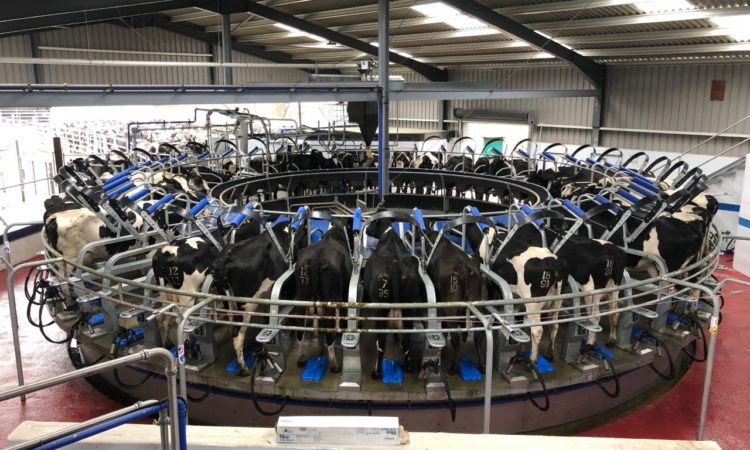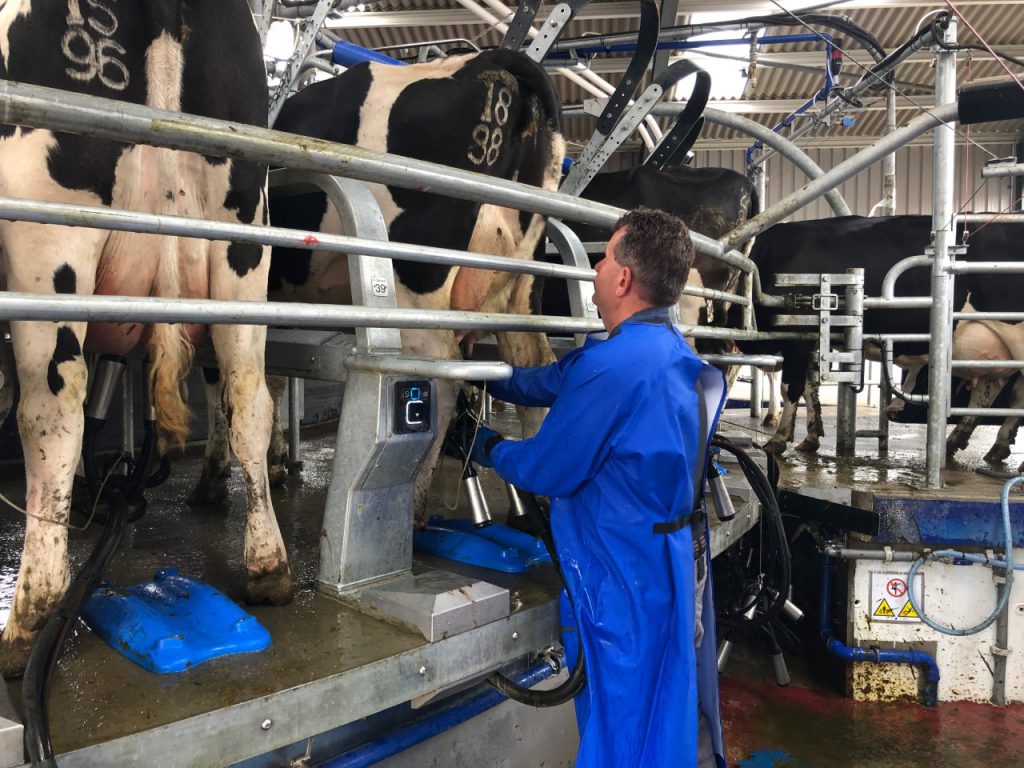In the next chapter of our ‘Back In Focus’ series, we rewind back to a 40-bail rotary parlour AgriLand visited during the summer on the farm of Michael Walsh – and his son Michael – who milk a herd of 250 cows.
Up until last year, the father-and-son team – from Ballyagran, in Co. Limerick – were milking 220 cows through a 14-unit herringbone parlour.
However, due to the fact that it was taking up to three hours alone to milk the cows, it was becoming a physically and mentally draining process.
Also Read: Buildings Focus: Milking 285 cows through a 50-bail rotary parlour in Co. WaterfordTherefore, the decision was made to upgrade the milking facilities, in order to make life easier and also to bring back the joy of milking cows once again.
Speaking about the decision to install a new parlour, Michael said: “The herringbone parlour was old and the fact that we had increased cow numbers – since the milk quotas were abolished in 2015 – we felt as if it was time to move with the times and upgrade.
Furthermore, the milking process in the old parlour was taking three hours in the morning and the same again in the evening – which is far too long to be standing in a pit.
“It was mentally draining [the milking process] for myself and also for our full-time worker – Joseph.
“Another reason for opting to install a new parlour was because my son, Michael, plans to continue milking after I finish up.
“If it was a case where Michael had no interest in taking over I would probably just have added a couple of extra units onto the old parlour and milked away for another few years.”
Layout
The new rotary parlour was built right in front of where the old herringbone parlour was. Therefore, when the rotary was completed, the Walshs were able to knock the old parlour and turn it into a larger collecting yard.
The project was designed by Aidan Kelly – of Agri Design and Planning Services. The building itself – which includes the concrete work and steelwork – was completed from start to finish by Benny Smith of Smithform Construction.
The shed, which contains the rotary parlour, is a five-bay building and measures 24.1m long and 18m wide. The build stands 7.7m high at the apex and 4.8m high to the eve gutters.
The collecting yard is 35.6m long and 12.8m wide; however, to aid with cow flow, there is a 4.8m angle at the front of the collecting yard to angle the cows towards the race.
The drafting and exit race area is 35.6m long and 5.6m wide. A slatted tank – located at the rear of the build – stores the animal faeces from the collecting yard/drafting area.
Speaking about the layout of the new build, Michael said: “It was great that we could incorporate the area where the old milking parlour was because we didn’t have much room to manoeuvre either side of where the old parlour was.
“The only way we could go – realistically – was out towards the roadway. Thankfully it worked out well. Moreover, it was great that we were able to continue milking in the old parlour, while the new parlour was being built.
“In fairness, the whole building process went smoothly, without any major hiccups.”
Rotary parlour
Taking a look at the features of the new build, the Walshs – after some careful consideration – decided to install a rotary parlour instead of a traditional herringbone parlour.
The father-and-son team had originally planned to go with a herringbone parlour; however, after weighing up a number of different factors, they felt that a rotary parlour was the best way forward for their farm.
The duo opted to install a 40-unit rotary parlour. The main features of it include: automatic cluster removers (ACRs); auto-teat spray pods; an auto-wash system; and feed-to-yield feeders.
Speaking about the new parlour and what it is like to milk in compared to the old parlour, Michael said: “It really has been a breath of fresh air. The task of milking cows has become enjoyable once again.
The old herringbone parlour was as basic as they come. We didn’t have ACRs, an auto-wash system or anything fancy like that.
“The best part about the new parlour is the feed-to-yield system. In the past, cows would have been fed the same amount of concentrates day-in day-out.
“However, now, we can feed a cow what we want to. We have two meal bins. One bin contains a ‘base feed’ – for want of a better word. It is fed at a rate of 2kg. All of the cows get this, which basically contains the ingredients that the cows need to prevent against any mineral deficiencies.
“The second meal bin basically tops up the 2kg of feed that the cows get. So, for example, cows will get 2kg – of meal – regardless of what they are producing and depending on how much milk they are producing they may or may not get extra meal.”
Michael added: “Our top-producing cows are getting about 9kg of concentrates a day. I would say on average – at the moment – the majority of the cows are getting 4.5kg of meal.
“After calving and at breeding the average would be a bit more. As the season progresses, I would expect that average to drop even more.”
He explained: “Cows can be very deceptive. In the old parlour, there were cows that I thought were producing good volumes of milk; however, when I milked them through the rotary I got a bit of a shock.
“The cows that I thought were doing well were actually producing less than the cows that I thought were performing poorly.
“So, the feed-to-yield is actually saving us money because the cows that are doing well for us are being rewarded and the cows that aren’t doing as well are getting what they need to keep them ticking over.”
Talking about the other features of the parlour, Michael said: “Everything from the ACRs to the auto-wash system have made the whole milking process so much easier and quicker to do.
Surprisingly, the cows and the first-time calvers took to the rotary very well. We had very little issues training them in.
“The only thing that Michael and I have noticed is that if the cows are coming into the parlour with a ‘full belly’ it can be hard to get them going. If they are coming into the collecting yard after grazing a heavy paddock, they seem content to just stand in the yard and aren’t as inclined to walk into the parlour.
“They need a bit of encouragement [to go into the parlour]; however, that’s more of a management issue than anything else.”
The Walshs opted to install a 15,000L bulk tank. The idea behind this was if they decide to move up in cow numbers again, they have the capacity to do so.
Cutting the milking time in half
One of the biggest reasons for installing a new parlour was the length of time it was taking to milk the cows in the old parlour.
Michael explained: “The old parlour was perfect for us before we started going up in cow numbers. Once we got up to 180 cows and eventually to 220 last year, it was becoming a lot harder.
“We used to have to get up at 4:30am to go get the cows and bring them into the parlour. Milking would start at 5:00am and it would last for three hours.
“The milk tank would land at the gate at 8:00am, so we had to have the cows milked by then. It was a constant fight against time.”
He added: “Our working days were lasting 14 hours and six of those were spent inside the pit of the parlour, so something had to change.
“These days – with the new parlour – it takes us about an hour and a half to milk the cows in the morning and about an hour and 20 minutes in the evening.
“We take it in turns milking. One guy goes and gets the cows, while the other guy is waiting in the parlour to meet the first cows that come in.
“By the time the person who is bringing the cows in from the paddock lands back to the yard, the person milking the cows would have 40 if not 50 cows milked by the time they arrive back – which is about 20 minutes.
“If that was the old parlour, you would be lucky to be on the second row of cows. The difference between the two is massive.”
Michael added: “Another bonus to being able to milk the cows quicker is that they don’t have to wait in the collecting yard for as long as they would have done in the past.
“Once the cows are milked they can head straight down to the next paddock. It has resulted in less lame cows – which, again, is another bonus.”
Drafting system
A common sight on many dairy farms – that have upgraded their facilities – is a drafting system. The Walshs were no different, having opted to install one themselves.
Speaking about the system, Michael said: “It has been a great help – especially during the breeding season.
Michael and I – when the breeding period was in full swing – would go through the cows when they would be in the collecting yard – before milking – and try to pick out any we saw in heat.
“If we picked out a few cows, all we would have to do is head into the office and enter the cows’ tag numbers in and the drafter would pick them up once they would exit the rotary.
“Again, in the past, the job of separating cows you wanted once they left the parlour was a two-man job. Now, once I put a cow’s tag number into the system I don’t have to think about her until the AI man comes.”
Cost
The project was carried out with the aid of the Targeted Agricultural Modernisation Scheme (TAMS).
Speaking about the new build and the cost of it, Michael said: “The project is standing to us at €400,000.
“It’s a long-term investment. Since milk quotas were abolished in 2015, we have steadily grown in cow numbers.
It had come to a stage where we needed to upgrade and the fact that Michael [my son] plans to take over from me when I retire was another key reason behind our decision to upgrade our facilities.
“Furthermore, over the last few years, land became available near our grazing platform – which we took on and that has allowed us to increase our herd to where it is today.
“As long as milk prices stay in around the 30c/L mark I think we will be OK. The goal was to make life easier and to have facilities in place that would allow us to work as efficiently as possible and I feel we have accomplished that.”

















